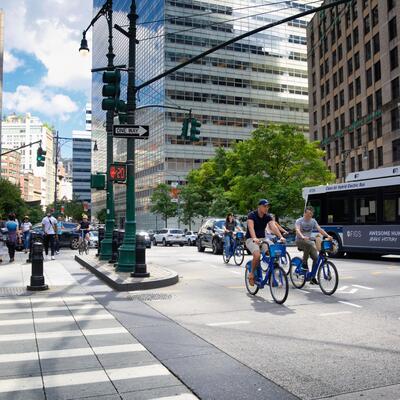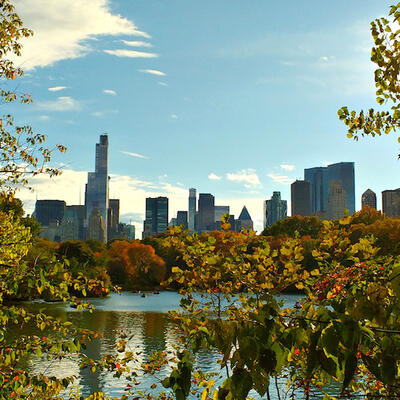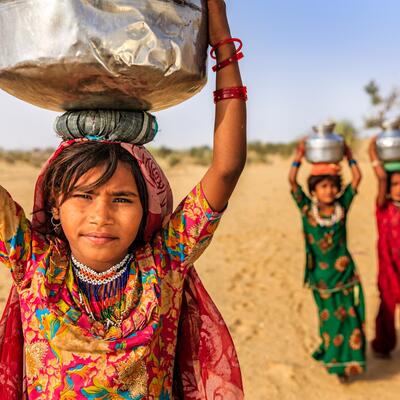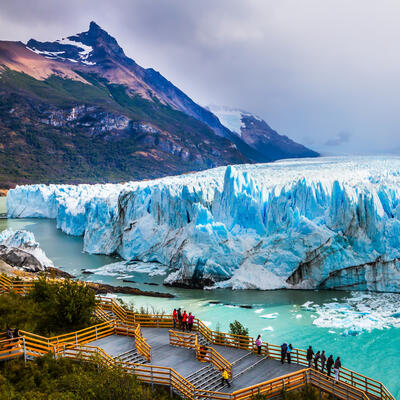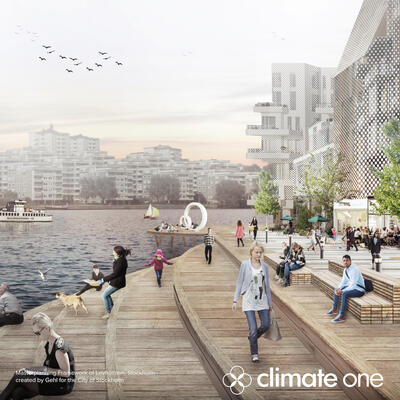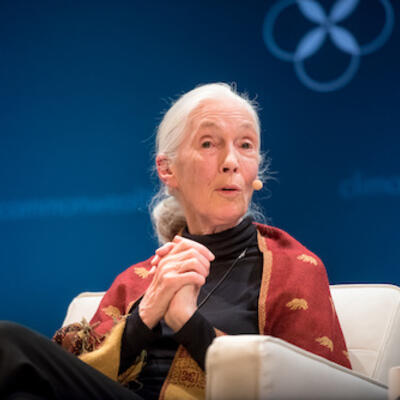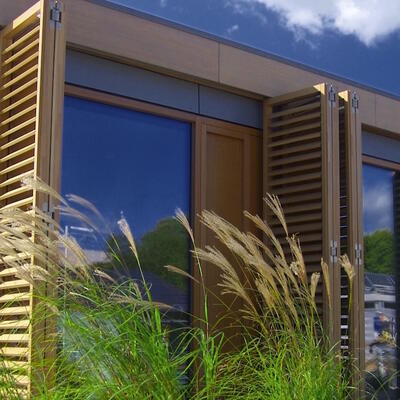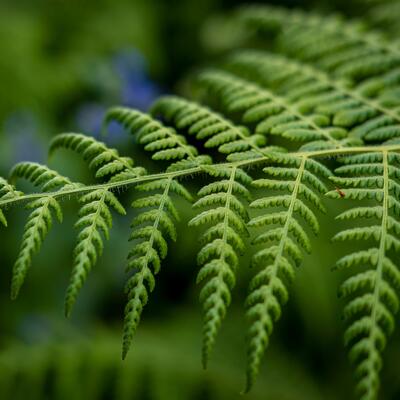
Biomimicry & Green Burial: Living and Dying with Nature in Mind
Guests
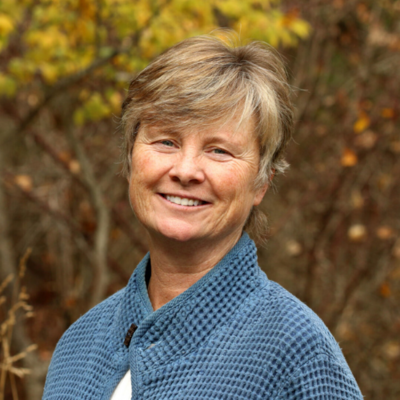
Janine Benyus
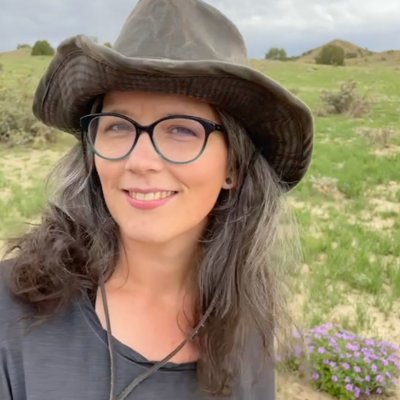
Emily Miller
Summary
Nature can feel distant from our everyday lives. Maybe it’s a place we visit on the weekends, a getaway from the hustle and bustle, something “out there,” just beyond the edges of our neighborhoods. But we are part of it, and as more and more people consider their impact on the Earth, sustainable practices are extending even to death, where green and natural burials are gaining popularity.
From mushroom caskets to human composting, green and natural burials are an option that can bring us closer to nature – and help minimize our carbon footprint – even after we die.
“What seems so different about a natural burial is the idea that the final resting place would be in nature, and it wouldn't be a manicured environment,” says Emily Miller, licensed funeral director and secretary of the Green Burial Council. She founded the Colorado Burial Preserve, the state’s first dedicated green cemetery, to provide this option within her state.
“There's a usefulness to dying and being returned to the soil. Where something beautiful can now grow because we lived and died,” she says.
Within the fields of design, many engineers, scientists and others find inspiration through biomimicry.
“Biomimicry is innovation inspired by nature. They look into the natural world and say, ‘what in nature has already solved what I'm trying to solve?’” says Janine Benyus, co-founder of the Biomimicry Institute.
For example, scientists looked at the wings of butterflies, black butterflies in particular, where nano structures on their wings absorb light and reduce reflection. Solar cell technology inspired by butterfly wings became much more efficient: “a 200% increase in performance,” says Benyus.
Just outside of Washington, D.C, the U.S. Coast Guard headquarters took a biomimetic approach to its building. “What you now have is a building that is not two towers, it's spread out. It's got a series of cascading waterfalls going from one flat rooftop to the next flat rooftop to the next. And each rooftop has wetland plants that are purifying the water, and by the time it comes all the way down the building, instead of having a parking lot, there's a lake and there are walking trails around that lake,” says Benyus.
Biomimicry offers strategies to build in a way that addresses climate concerns and has a softer impact on the environment in which it exists. “A biomimetic city would function like the wildland next door,” says Benyus.
Episode Highlights
2:26 - Janine Benyus on the definition of biomimicry
3:17 - Janine Benyus on increasing solar cell efficiency by looking to butterfly wings
10:21 - Janine Benyus on cooperation in nature
12:40 - Janine Benyus on optimism based on her work
17:15 - Janine Benyus on urban design inspired by nature
30:11 - A visit to the Fernwood Cemetery and Funeral Home
35:05 - Emily Miller on what a natural burial is
38:54 - Emily Miller on human composting
43:39 - Emily Miller on the Colorado Burial Preserve
Resources From This Episode (4)
Full Transcript
Note: Transcripts are generated using a combination of automated software and human transcribers and may contain errors. Please check the actual audio before quoting it.
Greg Dalton: I’m Greg Dalton.
Ariana Brocious: And I’m Ariana Brocious.
Greg Dalton: And this is Climate One.
[music change]
Greg Dalton: In these polarized times I’ve been thinking about how disconnected we all are - from nature, each other, from our food systems, our water sources, from the energy we use every day.
Ariana Brocious: (react) And it feels like that separation is often at the root of so many of the problems we face, including the climate crisis.
Ariana Brocious: We talk a lot on this show about connecting with nature to calm our nerves, find inspiration and remember our place in the wider universe.
Greg Dalton: I’ve been doing that recently by going whitewater rafting with my family in Idaho and Oregon. So it hit close to home when I learned of the tragic death of youths at a riverside camp swept away by flash floods in central Texas.
Some Officials in Texas are deflecting questions about how climate is related to the deadly flood on the Guadalupe River.
Ariana Brocious: The science is clear. Burning fossil fuels is causing warmer oceans and wetter air. Warmer oceans and more moisture in the air can amplify the power of storms, including this one.
Greg Dalton: Exactly. You can think of climate disruption as how WE are impacting the earth – specifically, when it comes to extracting and burning fossil fuels. But some people who help design and build the world around us are looking to the natural world for solutions.
Ariana Brocious: This is called biomimicry - where scientists, engineers and others look to nature to see where it has solved problems we’re still struggling with.
Greg Dalton: Exactly, there have been some fascinating innovations in nearly every industry. Like looking to lotus leaves to create rain repellent solar panels, or using wetland plants to purify water.
Ariana Brocious: And it’s not a new concept – velcro was invented back in 1941 by a Swiss engineer who observed how burs clung to his dog’s fur.
Greg Dalton: haha I wanted to get a better handle on how biomimicry is being used to address climate disruption, so I had a conversation with Janine Benyus, Co-Founder of the Biomimicry Institute.
Ariana Brocious: You’ve known her for a while, right?
Greg Dalton: We spent some time together learning about biomimicry in the mountains of Montana. She has spent decades applying lessons from natural systems to our economic and political systems.
Janine Benyus: Biomimicry is innovation inspired by nature. So it is a, it's a design practice right now and, and quite a popular one in which people who make our world, um, industrial designers, chemists, architects, engineers, um, when they have a question about how to solve a design challenge. They look into the natural world and say, what in nature has already solved what I'm trying to solve? And then they try to emulate that.
Greg Dalton: Yeah. Uh, earth has 3.8 billion years or so of research and development. There's a lot of wisdom in that. One example, uh, you know, obviously solar's big in these days. A lot of people have it. That's, you know, kind of learning from perhaps the, the photosynthesis of, of trees, you know, but there's also butterflies and solar panels. How are they connected and what's, what lesson has been learned there?
Janine Benyus: It's incredible. Yes. Um, you know, one of the things that, um, we need in a solar panel is to absorb as much sunlight as possible without reflecting that sunlight. We lose a lot because it bounces, it bounces back. Right. It reflects off, especially with thin film solar cells, which have the possibility of being, you know, ubiquitous building wraps, for instance. So there's a deep science in how organisms play with light butterflies, especially black butterflies. Um, they've got certain nano structures on their wings that allow the light to come in without allowing it to bounce back out. And we're able now to place, uh, a mimic of those structures, basically using life's blueprint.
We're able to put that onto the top of a solar cell. And scientists at, at Caltech and Cal Broad, uh, have done the measurements and found that it's a 200% increase. In performance on a thin film solar cell. Just by putting this invisible to your eye, this coating on top, that self assembles into, into this structure.
they're also mimicking, uh, lotus leaves. Which are these leaves that stay very, very, very clean even though they're in a swamp. And they do that because they have certain, certain kinds of structure on the leaf that that forces rain to ball up and then roll off, taking dirt with it.
So they're creating those kinds of structures as well to help the solar cells be self-cleaning in the rain.
Greg Dalton: And there's another example from, from food waste. You often have heard that there's no waste in nature. Like the, the poop of one animal is the food for another, and it nurtures soil. So what has been learned about food waste from nature?
Janine Benyus: Well, yeah. You know, how much food waste contributes to greenhouse gases. I mean everything from the farm to the fork, whether it's growing or, or distributing or transporting. When, when something, uh, rots with a billion people hungry. It's a social and environmental disaster, right? Food waste, and it's up to 40% of the food, fruits and vegetables are wasted. So there's, there's this amazing guy, Deepak Rajamond, uh, scientist from India. He came to the United States, studied plant chemistry. He actually went to Oregon Science Museum and saw Biomimicry exhibit.
Greg Dalton: Cool.
Janine Benyus: yeah, that we had helped with at the Biomimicry Institute. It's, it's a beautiful story and. He started to think about the chemistry that he was learning from plants. And there's this, um, system called plant defense system where plants, when they get attacked by microbes, for instance, um, apparent plant for instance, will send signaling molecules to the fruit saying, beef up your defenses. Just like our immune system. And so he, he decided that, uh, he wanted to go back to his home country, India. They're the second largest producer of fruit and vegetables in the world, and yet about 40% of the fruits and vegetables never make it to market. They get put on trains. They're not refrigerated, and they don't make it. And we have the food waste problem with climate. Fruits and vegetables are alive for
Janine Benyus: For days, weeks, sometimes longer after they're picked. And I don't know if people know that, but what that means is that if they were to receive the signal. To beef up their defenses, they would, but they're disconnected from their parent plant and from other plants. So what he's done is he's mimicked those signaling molecules, put them in a little packet. You put those packets in a crate of vegetables, and those vegetables now are lasting 40 to 60 times longer without rotting. It tells the fruit, to open its pores, tells the fruit to not ripen as quickly, tells the fruit to actually beef up its defenses against microbes. It doesn't change the flavor of the fruit and vegetable. He's worked with, I've seen amazing things with avocados, grapes, he's doing citrus now. Um, bananas. So this is a huge win for farmers and for the climate.
Greg Dalton: And that's really encouraging and learning from nature to solve human problems. And that's an example of kind of one species helping itself. There's also examples of mutualism in nature where species will kind of help each other out.
Janine Benyus: Yeah, mutualisms are mutually beneficial relationships in which two different species come together. A plant and its pollinator, for instance, right? The bee. The bee gets nectar and it spreads pollen for the flower, right? So it's this exchange or we, we know now about the wood wide web, right? We know about this, these microrisal fungi that are, that are under the ground, wrapped around roots, and they're actually conduits for all kinds of things, alarm signals and, and. All kinds of nutrients and nitrogen and water, but it starts with a mutualism between that fungus and the tree. The tree gives the fungus carbon after photosynthesizing and then the fungus gives the tree phosphorus and many other things. Um, and that, mutually beneficial relationship. It's really interesting, Greg, because for years and years and years, uh, ecologists believed that competition kind of ran the world. And the reason you see trees on a hillside spaced out the way they are is because they're in terrible competition with one another.
That's really been updated in the last 20 years, and what we realize is that yes, there are negative interactions like, like competition, predation and parasitism. Yes, but by far, most of the interactions in ecosystems and, and part of their magic is positive relationships. Where one plant is sheltering, another plant like a nurse plant, and keep creating conditions that are more beneficial for that plant. Or they're, you know, the leaves from a tree are nurturing another kind of species beneath it. Those sorts of mutualisms are much more prevalent in complex ecosystems than we ever even mapped or modeled.
Greg Dalton: Yeah. And the Buddhist would say that, yeah, there, the, the, the self isn't kind of an artificial boundary that we are connected to a nature in ways we don't, we don't realize. So it sounds like you're saying that nature is more generous and less brutal than we think from watching those nature TV shows.
Janine Benyus: We've really paid attention to the negative, uh, interactions in the natural world. And, and when I say negative, I simply mean that competition is a negative for each of the species that are in competition. It's expensive. it's a negative for both if you're in head-to-head competition. Life, nothing. Nothing exists in isolation. It is literally dependent on so many other things. It's in its environment. In the Anthropocene. Now we're beginning to realize that sort of interdependence that we have. We in Western industrial culture. Indigenous people who have, and people who have lived embedded in their ecosystems for thousands and thousands of years understand fully that they are dependent on the health of other organisms for their own health. Right? And so I think that's dawning on us. And science, um, is showing us now that indeed, when we do map out the mutualistic networks in an ecosystem, they are ubiquitous and they are essential to having that ecosystem get better and better and better each year.
Greg Dalton: After the break, we’ll continue my conversation with co-founder of the Biomimicry Institute, Janine Benyus.
Janine Benyus: When you begin to think of your building, your infrastructure and your landscaping in a way that's welcoming to biodiversity, you automatically begin to have these benefits that go beyond your borders.
Greg Dalton: That’s ahead, when Climate One continues.
Ariana Brocious:Help others find our show by leaving us a review or rating. Thanks for your support!
Greg Dalton This is Climate One. I’m Greg Dalton.
Let’s get back to my conversation with author and co-founder of the Biomimicry Institute, Janine Benyus.
[music cue]
Greg Dalton: So does your deep connection to nature leave you less depressed than the other people in my life and climate people that I talk to?
Janine Benyus: Oh my gosh, I'm not sure about that. Um, I. Am a, a pragmatist. Um, and I do the reading that you do, and I am very attached to this sweet world. Um, and it's, it's incredible exquisite intricacies that have built up over 3.8 billion years. I mean, I realize that the organisms we're living with right now are the ones who have really figured out how to be earthlings. You know, 99.9% of all species that have been on earth are extinct, right? So the ones that are with us they're a living library. They're, they're the genius that surrounds us. And so, yes, I, I mourn every bit of the Earth's plasma, you know, sloughing away. I really do. I also know enough about resilience, and adaptation in the natural world to know that organisms and their ecosystems are highly, highly attuned to changing conditions and adapt accordingly.
And I also know that we're a biological being. So I am rooting for that biological vulnerability to get through to us, to get through our denial, which is also very strong in human culture right now. But when that, when that comes through to us,I'm rooting for the fact that. We will knit ourselves back together in a way that makes us better earthlings.
The way I think that's going to happen is that our systems will begin to learn from and look and, and, and function more like the living systems in which we're embedded. In other words, culture is, you know, a set of values. It's what you pay attention to and it's what you value. And if we decide to value how Life on Earth has lived here for 3.8 billion years and made it better and better each year, then we will turn to those lessons.
And thankfully we've been studying those lessons.
Greg Dalton: We are seeing technology moving so fast, climate change moving so fast. So how do we get cultural evolution to also move fast?
Janine Benyus: So genetic evolution, um, which is what organisms are, are working with. They also have culture as well. But what they are working with in order to adapt, is not fast enough. They're trying. Organisms are on the move. They're, they're heading north for cool. They're heading up mountains for cool. They're on the move and they're adapting. As they do that, there's, the thing that keeps me up at night is this uncoupling of mutualisms. So when an organism, like say a flower moves north, but its pollinator doesn't.
Greg Dalton: Mm-hmm.
Janine Benyus: That uncoupling is, is really what I think that scramble, um, is, is something we're gonna really have to work with in the coming years. And so cultural evolution has an advantage over this genetic evolution and that advantage is that it can build on itself. Our knowledge can snowball. We don't have to, you know, figure out electromagnetism again, each generation. Right. We can, we can jump from there. That, that cultural evolution, if it is employed towards a goal that we collectively agree on. Um, I think that's what will help us get through this evolutionary knot hole that we're heading for, and hopefully bloom on the other side and take as many species with us as we can.
Greg Dalton: Right. You know, 'cause culture is powerful, can shape quickly. That can be both good and bad. Another thing that's moving quickly, you know, humans are moving into cities, cities are expected to grow by about two or 3 billion people, which means expanding and building a lot of buildings, uh, and how we urbanize will have a big impact on the climate. So what can we learn from nature about how human civilization becomes more urban?
Janine Benyus: Yeah. Say 3 billion people come into cities between now and 2050, that means that we will be, are, building the equivalent of a city for 1 million people every five days between now and then.
Greg Dalton: Wow.
Janine Benyus: So we said, okay, if we want impact, if we wanna bring nature's wisdom to a place that really needs it, it's going to be the built world. And we also know, you know, the greenhouse gas impact, for instance, of building and construction,
Greg Dalton: Mm-hmm. Mm-hmm.
Janine Benyus: So. Our clients began to ask us, how would nature build a city? How would nature build a building in a site? Because every corporation in the world is doing that. Our clients, um, our clients are also municipalities. Um, and what we said was, a biomimetic city would function like the wildland next door. If you flew into it, like I fly into Missoula, Montana, I live south of Missoula. I fly over thousands and thousands of acres of wilderness and I look down and I can imagine how it performs. I can imagine, you know, clean air sparkling streams, bird song. The smell, the fragrant soil. I, I know what the healthy feels like 'cause I've spent a lot of time back there. But then I get to the city and I look down and I think to myself, what if functionally there was no change?
What if it functioned like the wild land next door? We have partners that we work with. HK is our architect, Jacobs, our engineer, Eco Metrics Group is our software, uh, company and our modelers. We found an ecological model that allows us to go to the wildland next door. Literally, if a client wants to put up a new data center or a new eco district, we go and find the most intact habitat that we can, and we measure all the ecological gifts. The benefits. They're called ecosystem services coming from that forest, say. And so we measure how much water is being stored, cleaned, how much air is being cleaned, how much wildlife is being supported, how much cooling is happening, how much noise abatement.
We look at about 21 ecosystem services. We get metrics. How many gallons per year, per acre? We go back to the site, the building site, and we say to the design team, here are the new metrics, the new KPIs, key performance indicators you need to meet in order to function like the wildland next door. And it really changes design.
Literally nobody wants a new development in their backyard. It's, it's nimby. How do you turn that into, please? In my backyard, Piby, instead of not in my
Greg Dalton: That's a.
Janine Benyus: You do it by being a welcome neighbor. So let me give you an example. Um, 'cause it's hard to imagine how, how is a development, the building and the site going to perform all of these ecosystem services? So our. Our, um, partner, HOK did this amazing, uh, landscape architecture project. It was a building for the US Coast Guard. It's their headquarters outside of DC and it's in the Anacon Costa, uh, river drainage, and it's on a sloped site. And, you know, normally for a headquarters you'd put up a couple of tall towers, but we said to the Coast Guard, you know, what is it you do? And they said, well, our tagline is that we protect the nation's waters. So we said, why don't, we lean into a water purification project.
Greg Dalton: Makes sense.
Janine Benyus: And they were on a sloped site and water was coming in. Um, you know, it piped, uh, you daylight these, these piped streams.
Um, and what if the building was the water purification device? and you can go online now and look at it. US Coast Guard headquarters, it's incredibly beautiful building. So what you now have is a building that is not two towers, it's spread out. It's got a series of cascading waterfalls going from one flat rooftop to the next flat rooftop to the next.and each rooftop has wetland plants that are purifying the water that comes in and then goes down, and by the time it comes all the way down the building, instead of having a parking lot, there's a lake and there are walking trails around that lake. And of course, in addition, the building itself purifies that water. Everybody gets a view of those incredible blue-green roofs. People in the neighborhood can walk around and watch wildlife by that lake. The cars are underground. We also planted, you know, amazing numbers of diverse native species of trees and shrubs, and they are attracting wildlife. What happens when you begin to think this way is that you try to collect all the ecosystem services you can. So you're saying, okay, we're gonna put up a green roof. Well, why not put a pollination station there or plants that are pollination, or, let's purify water. Let's make sure we're cooling the air. Let's make sure we're abating noise. Let's make sure we're bringing in support for wildlife that can nest there.
When you begin to think of your building. Your infrastructure and your landscaping in a way that's welcoming to biodiversity. you automatically begin to have these benefits that go beyond your borders. You become a welcome neighbor.
Greg Dalton: That's wonderful. And yet there's still a question of like, you know, does this cost a lot? You know, did the. Coast Guard pay, uh, an extraordinary premium to have a building on 175 acres for 4,000 workers that works as a water purification system, which aligns with their mission. I get that, but how scalable is this and affordable?
Janine Benyus: Yeah. You know, it's interesting. Um, there are many reasons, different reasons that clients will do something like this. Um, create a truly generous design, a biomimetic design, and for some of them, for many of them, um, it's a human health question. It's employees health. And you know, the research now, the evidence-based research is showing that people are healthier, they recover faster for instance, in hospitals, if they have a view of, of greenery. Um, and that means a lot to a company that human health angle of it, but also this idea that you're a good neighbor. You know, people used to do beautiful facades on their buildings so that people walking by would have a delightful experience.
Right? That was part of what you did as a corporate citizen, and this is, this is a new era. We are in an era I think, where we need to have. Architecture be a healing art. And everything we do actually, we've got a lot of things to repair on this planet, to bring it back to flourishing.
Greg Dalton: Your own neighbors. You know, you live in a, as you mentioned in a very conservative district south of Missoula, Montana.
Uh, and I'm curious about your relationship with your neighbors, you know, ranchers who probably don't use the same language or share the same lifestyle or politics as you do. Um, can you tell me about your neighbor who kept urging you to call his chemical guy to treat your land?
Janine Benyus: Yeah, that's right. Yeah. We, I mean, you know, we live surrounded by these large acreages, um, thousands of acres, literally, and we have eight. My partner and I, we moved here and what we could afford was a completely destroyed landscape, uh, it was overgrazed by horses. There were two one acre ponds, but no open water. They were utrified. That was, that was 35 years ago, andI'm looking out at it right now. It's just lush and green and bird loud, uh, gladed. It's incredible. Um, I would just say to everyone. Go ahead and run outside right now after this interview. And plant a tree. Just plant a tree. But anyway, so we had this big pasture between the two ponds and it was all Russian spotted knapweed. It was a, an invasive weed that is allelopathic and puts out chemicals that kill everything around it. goats, like napweed. So we tried 12 years of herding goats there. And then we would broadcast, you know, native seeds and, and of course all of our ranchers around us were watching and. They would kid us. And we had this one rancher, uh, neighbor who owns a huge amount. Um, and it's just beautiful. His pastures are a thing of envy. t. But he would say, you know, let me just give you my chemical guy. And we would say, no, no, no, we can't do that.
And one day it was 12 years in and. I went out and I was looking over the fence and we were so excited 'cause the napweed had started to really, really go away. There was only about 15% nap weed and it was all green, but in two weeks it turned completely brown and it was another weed. The entire thing was cheatgrass. Which is even worse. It's an annual weed and I was really in despair and here comes my, my rancher neighbor and he comes over to the fence and I said, okay, gimme your chemical guy's name. And he said, I don't have a chemical guy. And he said, and don't worry, this is the pivot crop. It's gonna be fine next year. You did it and next year. All those seeds we had broadcast seed in all those native seeds just went whoosh and literally was above our heads. There was big blue stem above our heads. It was, it just, it just took off. It finally got to that point of it knit itself back together and it became this incredibly flourishing system. And it is to this, to this day. They've, you know, it's fifth generation and they don't use chemicals. They really take good care of the property. And, um, and they were rooting for us. Uh, and yes, we have political differences right now. and yet nobody argues about the importance of taking care of your land. In fact, when we first moved there, people said, look, the only thing we care about, we don't care about where you worship or who you love. The thing we care about is how you treat your land, your water, and your animals. And we'll be watching for that.
And they do. And they do. And they help you.
Greg Dalton: That's a beautiful, uh, place to, to end. Thank you. Caring about land, water, and animals and maybe putting politics aside and focusing on what we agree on. Thank you so much, Janine, for joining us.
Janine Benyus: You bet Greg.
Ariana Brocious: Death is a natural part of life, even though we don’t often talk about it. Coming up, a fresh take on returning your body to the earth.
CLIP: This is not just an art piece. This is a real casket that's made of mushrooms.
Ariana Brocious: That’s up next, when Climate One continues.
This is Climate One. As the climate crisis intensifies, more people are thinking about their impact on the earth - not just in life, but also in death. Climate One Producer Megan Biscieglia went to the environmentally conscious Fernwood Cemetery and Funeral Home, in the Bay Area to learn more.
Megan Biscieglia: Driving up the winding road to Fernwood Cemetery and funeral home. I'm greeted by two baby deer and their mom. Aw, that's cute. Fernwood is nestled among the trees on a hillside, just a few miles from the coast. They offer both conventional and green burial. Nicole Ladd is the general manager.
Nickol Ladd: It really is up to the family and it has to feel right for them, and we're here to honor what feels right for them.
Megan Biscieglia: The green option doesn't use embalming fluids, metal caskets, or concrete vaults. The body is not preserved in any way, so it can decompose and return to the earth naturally.
Nickol Ladd: Some of our families say, no, you know, we don't want our mother touched at all. Great. We'll bring her into our care. She's safe here until you choose those next steps and others say, we wanna be a part of that process.
We want to help bathe mom, for example, in lavender oils and wrap her and, and take care of her, and those are ancient traditions of caring for our dead
Megan Biscieglia: Service assistant, Sonia Getz, shows me a few of their shrouds and casket offerings, including one that looks kind of like an oblong marshmallow.
Oh wow.
Sonia Getz: This is not just an art piece. This is a real casket that's made of mushrooms.
Megan Biscieglia: Wow. It's really neat.
Megan Biscieglia: People can choose to be buried in caskets, made from untreated wood, wicker, or ratan. Some simply choose to be buried in a shroud. Ladd and Getz lead the way to a golf cart so we can tour the ground.
Nickol Ladd: Shall we go on a tour? What do you think? Hopefully, hello, we're taking the easy route. Enjoy your hike. Thank you.
Megan Biscieglia: Are they just some hikers?
Yeah, it's definitely a place you can walk around. People take their dogs on walks here. It's very much a place for the living as much as it is for their loved ones who have passed on.
Megan Biscieglia:The cemetery is connected to the Golden Gate National Recreation Area and Trail Network. Here on the Greenhill side, we're surrounded by coastal oaks, towering eucalyptus, and redwood trees. When it's not foggy. There's a view of Mount Tamal Pius. And do green burials happen just like all over the place?
Like are Am I, what? Am I looking at? A green burial site? Yeah,
Sonia Getz: a hundred percent. Oh, this is all green burial.
Megan Biscieglia: Okay. So yeah, it just looks like a normal hiking spot with rocks. And the rocks are the grave markers, right.
Sonia Getz: Yes, the rocks are the grave markers. Families can choose a boulder or bring in one of their own if like they have a special rock from a special place.
Um, and then we engrave here and place the boulder on the site.
Megan Biscieglia: Yeah. I feel like if I was just driving through up here, I would not know that this was like a graveyard.
Sonia Getz: The beauty and simplicity comes from just our natural surroundings. At Fernwood, we don't necessarily need like a fluorescent green manicured lawn
Megan Biscieglia: back down near the main building. I run into the hikers. We passed earlier. Elsa Trantor and her friend Mary Ross Lynch.
Elsa Trantor: My friend Mary and I were visiting our dear friend, Vera Balmsey, and I get emotional just saying her name. She died 11 years ago and um, she was a good hiking friend of ours and so we're out here visiting her grave. Um, it got me thinking about afterlife and everyone in my family, in my immediate family, our ashes are all scattered.
Uh, in general places, so there's nowhere to go visit, but I really love coming to visit her. It's very peaceful and it's very unobtrusive, and her stone is just a small stone with some words on it, but it's not a monument or anything. So we're gonna walk to Tennessee Beach now, um, and then have lunch on the beach and it's just nice to visit her on the way.
So it's very pleasant as well as meaningful. Cool. Yeah. Yeah.
Megan Biscieglia: Here, even though we're surrounded by Graves, the place feels very much alive. For Climate One, I'm Megan Biscieglia
Ariana Brocious: To find out more about the many shades of green burial, I had a conversation with Emily Miller, Licensed Funeral Director and Embalmer and Secretary of the Green Burial Council.
Emily Miller: For me, what seems so different about a natural burial is the idea that the final resting place would be in nature, and it wouldn't be a manicured environment, not something where they have to do the mowing and edging and fertilizing every Tuesday, but just that it would be back to the earth in a more simple way, and then the setting would have this beauty, the way we feel when we're out in a natural space.
Ariana Brocious: We've been burying bodies for as long as we've been around, right? Um, and there are many ways of doing this. Natural burial means no embalming has been used, so the body is not preserved in any way. It can decompose naturally. Muslim and Jewish burials have followed these natural burial practices throughout history for cultural and religious reasons. I was unaware of the carbon footprint that goes along with cremation. I think I was under the impression, which I'm guessing many of our listeners are too, that this, that cremation is somehow, a better, more sustainable option because your remains are smaller, dispersed. Maybe you're not taking up space in, in a cemetery, for example. So what is the actual impact of, of cremating a body?
Emily Miller: I agree with you that, uh, it seems on the surface, like it might be simpler because it involves less of the stuff of a conventional burial, no casket, no land, as you mentioned. Um, but cremation has a big footprint in terms of the fuel it takes to run the cremation retort. This is several hours at 1400 degrees. It's about as much fuel as three months of your daily driving. Um, and it also turns the body's carbon, the carbon molecules that are in our body into CO2 directly. That's the intention of the cremation process to, to render the body's soft tissues into only CO2 and steam. Um, but instead of sort of returning to the earth in a way that the nutrients can be reused, this turns the body's carbon directly into a greenhouse gas. And then in some cases there's also problems with what is gonna happen to the cremated remains once that process is finished, uh, when they're introduced into nature. They're salty and they're, they're high in pH so that can be, uh, it can burn plant roots and it can also create a, an algae bloom due to phosphorus runoff. So we have to be mindful of how the cremated remains themselves are gonna be returned even after that intensive process is finished.
Ariana Brocious: So, from a climate standpoint, how does, a natural burial, differ from a conventional burial?
Emily Miller: With conventional burial, we have a big carbon footprint on the merchandise that comes to the cemetery with the body for the burial. So the casket can be metal, it can be wood. These things are extracted and shipped around the country through the manufacturing process and all of that has a footprint. We also have an outer burial container or vault in a lot of cases that's made of concrete, which has a big CO2 emissions footprint while it's curing. Um, and so we are burying these things out of habit, not necessarily because they're required something about death or something about cemeteries requires them to be so, extractive and, and emissive. But, uh, in practice, in our culture, that is what's happening. Uh, you also have to look at the management practices of the cemetery itself. You have your herbicides, pesticides, the fuel that runs the mowers and the trimmers and all of that.
Ariana Brocious: And there are a few other options. A couple of these I was totally unaware of. One that's I think becoming a bit more prevalent is what's known as human composting. So how, what is that and how does that differ from a natural burial?
Emily Miller: Yeah. Uh, natural reduction or body composting, it's similar to a natural burial in that the goal is to convert the body's soft tissues back to rich, usable soil. But in the burial, we just let the microbial and soil processes take place at, at nature's rate. In a body composting, we have technological means of controlling the oxygen levels, the moisture levels, and the temperature to convert the body's soft tissues in a controlled environment. So instead of an unknown amount of time, it takes weeks to months to become this finished compost soil-like product.
Ariana Brocious: Right, and then there's something called water cremation. What is that?
Emily Miller: Water cremation is a lower emissions form of cremation. Instead of this flame filled retort, it takes place in a chamber that's filled with heated water that's very alkaline. It's high pH and that, uh, dissolves the body's soft tissues. The water is in most cases, sent to a water treatment plant and, and what's returned to the family is the remains of the bones, very similar to a flame cremation you, you take home an urn.
Ariana Brocious: This is something most of us don't think about or don't spend a lot of time thinking about what might happen to our bodies. Um, and if we do think about it, it's probably a decision made based on the experiences of our own lives, the funerals we've attended, what we sort of assume is the norm. As you've been in this field, how have you seen this sort of, um, cultural understanding of death and burials change?
Emily Miller: I think that the conventional funeral, the one with all the trappings as, as popularized by our grandparents and before them's generation, the rise of the modern funeral cemetery industry. I think that service has become increasingly alienating for people. There's also the way the person might look after the embalming. There's also the growing secularity of our culture, a step away from a religious tradition. And the combination of all those factors has left people saying, wow, I, I really don't want that kind of funeral that my grandparents had. I don't understand what all that stuff was for. Um, and I think that's a partial contributor to the rise of the cremation rate in our culture when it was popularized it was because it was offering a alternative to, uh, well, let's, let's scale it down. Let's scale it way down to not have any of that stuff and sort of just convert the body through this, this process. Natural burial is offering kind of a middle ground where we can still have ritual with the body. We can still gather, we still have all the benefits of a final resting place in a cemetery. But we're not on the hook for all those things that don't really make sense or that we wouldn't want to, um, pick out of a catalog if we didn't have to. Along with that, you have a growing number of people who are concerned about their environmental impact of our lifestyles. And, you know, if you're someone who is a really conscientious shopper, we're composting and solar power at home, you know, it doesn't make sense. To be a polluter and a consumer in death, either. Our choices around death are an extension of our lifestyles.
Ariana Brocious: How do you factor in land use of green burial or natural burials as part of this overall environmental impact that we've been discussing compared to some of these other methods?
Emily Miller: Yeah, you mentioned it already, that cremation sort of seems like a better use of resources because it doesn't take up, or it doesn't usually take up a, a, a spot in a cemetery. But natural burial offers us a wonderful opportunity to protect and conserve land. And when we combine it with management for native species, native ecosystems, this becomes, you know, we're no longer wasting space, but we're holding space. The cemetery can can be at the same time, both, uh, an answer for what to do when there's been a death, and also a way to foster biodiversity, uh, sequester carbon through a healthy functioning ecosystem and just plain preserve beauty for future generations.
Ariana Brocious: Well, very nice segue to another aspect of your work, which is the founding of the Colorado Burial Preserve. This is the only burial ground in the state of Colorado that has an ecological restoration footprint.
Ariana Brocious: So what does the Colorado Burial Preserve look like and feel like?
Emily Miller: Uh, it's a shortgrass prairie environment. It's actually a transition zone into some characteristics of a pinyon juniper woodland. So this is Colorado at its most basic. Um, uh, if you're not from here, you would probably notice the wide open spaces. It's not a forest. Um, and we do have mountain views in almost every direction. This is, uh, converted ranch land. So we have a somewhat degraded ecological state into which we've added our burial program, which includes a restoration project. So we're planting over 30 different species of short grass, prairie grasses, wild flowers, cacti shrubs, um, to, to, yeah, just nourish the land there and, and do our best to leave it better than we found it.
Ariana Brocious: So if a prospective client were to come to you and look for a natural burial on this site. What is the ceremony and the, and the planting and that all kind of look like?
Emily Miller: I do my best to encourage the families to participate in the burial process, in every way that they're comfortable with. So, certainly we want them out there to witness it. But also we'll have them participate as far as, um, bearing and in some cases lowering the body just by hand with straps. The grave for a natural burial is shallower. It's about three and a half to four feet deep. We do that to create the best oxygen rich environment for the decomposition to take place at that depth. But it also means that it's relatively safe for the loved ones to approach the site to participate at. With their very hands and to to be as hands on with it as, as they might want to. and when they do stay through the shoveling the backfilling process, we plant the wildflower seed mix with. Them together. That's the final step of our interment process, is to go ahead and restore the whole area of the grave itself. And then also, um, any spot that's been disturbed by our gathering, our foot traffic, our equipment. Um, but for me it's an important part of the process to, to give back in that way, to, to begin the process of new life thriving there. Um, and I, I invite the guests to participate in that as well. I think it does us a lot of good around the time of a death.
Ariana Brocious: Access to green burial can vary significantly depending on where you live. There are no laws that explicitly prevent green burial, but there there's some outdated state laws and local laws that have made it more difficult in some places. Why don't all cemeteries offer natural or green burial options?
Emily Miller: Um, the number of cemeteries that offer this is growing. I think they're listening to our, their constituents, their communities that these options are desired. But to be honest with you, I think a big part of it is they've, they've grown up in a business environment in which they make a significant margin on this merchandise. The caskets and the outer burial container. That vault also offers a simplicity for maintenance for, uh, the, the purpose of the vault is to protect the grave from, from changing in its topography as these natural processes reclaim the body. If you have a vault there, you're never gonna have any sort of lumpy, bumpy cave-in. Uh, you'll have a nice flat surface for mowing. And it means that, uh, there's fewer trip hazards out in the cemetery as we're trying to, um, conduct funerals out there with our, uh, guests of varying physical abilities. but yeah, I think that conventional cemeteries are used to requiring vaults and that's why they still do.
Ariana Brocious: Hmm. You've explained how conventional cemeteries can be maybe sterile in a sense, or very manmade spaces, human controlled spaces where we eliminate pests and weeds and things like that. By contrast, the Colorado Burial Preserve is this, you know, wild space that you've been describing, a conservation space. So how does studying what happens on the land there itself inform how you think about death personally?
Emily Miller: One of my favorite examples is to do with the juniper trees in the preserve, and we have them in all stages of life from just tiny little sapling sprouts to big thriving shrubs and trees, to ones that are decaying and also ones that have died. And your conventional cemetery, or really any type of human development, taking out dead trees is like the first thing we do, like, let's clear away all those eye sores and, and, you know, hazards to our building. But in fact, the areas surrounding the dead and dying junipers in the preserve have some of our best biodiversity of wildflowers. Because there's a chemical advantage to the places where the roots are being returned to the soil. And the skeletons of these junipers also collect water a little more. They provide a little bit of shelter and, you can see when, when you take the hiking trail, how, uh, the, the amount of plants is, is thicker there. It's richer there. And also. Some of our most interesting species are found in, in the roots of these dead trees. And so to me it's just this, you know, visible, beautiful example of how even in death we are needed by the soil and by the other members of the community on this planet. Um, and there's a usefulness to dying and being returned to the soil. Um, where yeah, some, something beautiful can now grow because we lived and died.
Ariana Brocious: Hmm. That's so nice. Emily Miller is a licensed funeral director and embalmer and founder of the Colorado Burial Preserve. Thank you so much for joining us on Climate One.
Emily Miller: Thank you so much for having me.
Ariana Brocious: And that’s our show. Thanks for listening. Talking about climate can be hard, and exciting and interesting — and it’s critical to address the transitions we need to make in all parts of society. Please help us get people talking more about climate by giving us a rating or review. You can do it right now on your device. Or consider joining us on Patreon and supporting the show that way.
Greg Dalton: Climate One is a production of the Commonwealth Club. Our team includes Brad Marshland, Jenny Park, Ariana Brocious, Austin Colón, Megan Biscieglia, and Ben Testani. Our theme music is by George Young. I’m Greg Dalton.
